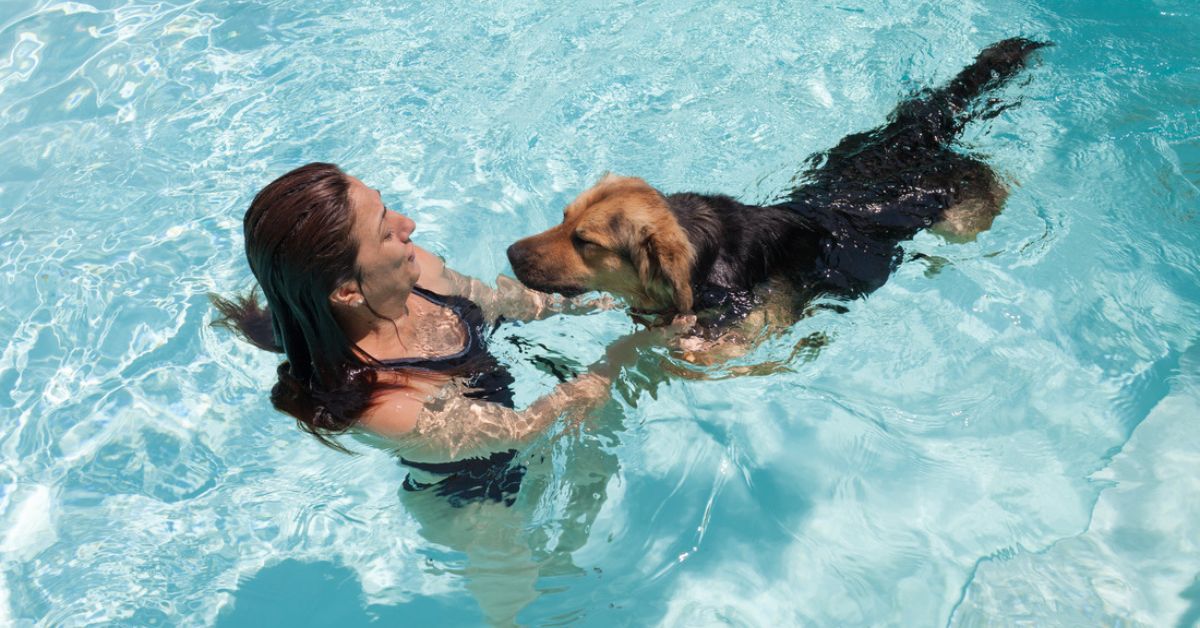As swimming is a fun activity, and everyone enjoys it. Even when dogs see the water, they get too excited to jump in. To make your dogs healthy and active, there’s no better way to teach them to swim.
However, not all dogs naturally know how to swim; some may even be afraid of the water. If you have a pool and want to teach your furry friend how to swim, don’t worry! With patience and some easy-to-follow steps, you can quickly help your dog become a confident swimmer.
Moreover, no matter what the swimming pool colors, designs, and locations are, pets are always ready to play with the water. Keep reading this guidance for training dog swimming skills.
Essential Steps on How to Train a Dog to Swim
Training your dog will going to be a fun and rewarding experience for you and your doggy. So, here we’ve mentioned some steps that will help you to teach your puppy to swim properly:
Bring Your Dog into the Pool Safely
It’s common for the first time your puppy may be nervous to see the deep water. If your dog doesn’t enter the water, the best way to help them is to take it slowly. Firstly, introduce your pet to the water, like the entry steps.
Make sure your dog can stand comfortably with their head out of the water. Place a leash on him, and walk gradually onto the top pool step while gently encouraging him to follow you. Your aim is to make your furry friend feel comfortable and at ease while being in the water.
Be in the Water with Your Dog
You should be in the water with your dog because you can better control and support them if something happens. For example, your dog will likely follow you into the water when you lead him.
It’s possible your dog doesn’t leave your hand in starting, but you should slowly get away from him to teach them to swim independently. It doesn’t mean you should leave alone the dogs in pools; you can support them in the water by holding the handle or suggesting how to swim around you or away from you with a treat or a toy.
Teach Step-by-Step Technique
Once your doggy is easy and comfortable in the water, the next step is you should teach him how to go deeper gradually. Take it step by step, allowing your pet to relax at each level before moving on to the next one.
If your dog is too small, you can try another approach to teach dog to swim in pool alongside using the steps. Hold your dog like cradling a baby against your shoulder, and slowly walk into the water. Pause every few inches to see how your dog is feeling as her body gets partially submerged.
As the puppy is on the second or third step and his body is up to the neck in water, walk him back and forth in the pool. This helps him to be habitual in the water; over time, he’ll become more comfortable with the experience. The key is to take it slowly and let your furry companion adjust quickly.
Provide Support When the Dog Starts Paddling
After your dog feels safe with the water up to neck level, gently coax them into deeper water so they start paddling to stay afloat. If your pet has a flotation device or not, immediately move to assist him if they struggle.
Place your arm under their stomach or ribcage for support, allowing them to paddle efficiently with both front and back legs. Encourage your dog to keep its head up and neck forward while paddling, enabling clear vision and easier breathing. As your dog becomes more confident in paddling, gradually reduce your support. In case they need help so, stay close to them. When your dogs in pools swim properly, you’ll be glad to see them.
Guide Them How to Get Out of the Pool
The steps in the pool are available for human use. So, don’t expect that your dog knows how to exit from the pool on its own. While you’re trying to teach dog to swim in pool you have to show them where are the stairs and how to use them to get out of the water.
Start by using a leash to guide your dog up the steps and out of the pool. Repeat this several times until your pet remembers them. Once your dog starts to swim well and understands the steps, try letting them do it on their own.
Have another family member wait at the top of the steps while you and your dog enter the pool. Lead or carry your dog away from the steps and let go while the family member calls your dog to come out of the pool. Once your pet has the exit path down, repeat this exercise several times on the same day.
This training is crucial for your dog’s safety. Practice it on different days and let your dog enters the pool from various locations so that they can find the steps from anywhere inside the pool. Revisit this training after a month to reinforce their learning.
Life Jacket is Necessary
When you see dogs swimming in pools, set a controlled environment like a hydrotherapy pool or a quiet pond/lake with a gradual incline, no currents, and waves.
Experts suggest using a life jacket on your dog for their first swim. It ensures a positive experience and prevents panic if they can’t touch the ground. The life vest allows them to float and start paddling with their legs.
A life vest also helps balance your dog, as some new swimmers may use only their front legs. Look for a durable, adjustable, and brightly colored life vest with a sturdy handle for easy lifting. Remember, all dogs, even good swimmers, should wear a life jacket on a boat for added safety.
What Benefits Dogs Can Get from Swimming?
Teaching how to get dog to swim in pool can provide numerous benefits to puppies, both physically and mentally. Look at the several potential advantages include:
- Low-Impact Exercise: Swimming is a low-impact activity that puts less strain on a dog’s joints and muscles than running or jumping. It’s an excellent option for dogs with arthritis, joint issues, or those recovering from injuries.
- Cardiovascular Health: Pool activity is a great cardiovascular workout for dogs that will assist in improving their heart and lung health. Regular swimming can enhance overall fitness and endurance.
- Weight Management: If you want help to overweight or obese dogs shed excess pounds, swimming is an effective way. The buoyancy of the water reduces the stress on their joints, making it easier to exercise and burn calories.
- Mental Stimulation: Swimming can mentally stimulate dogs, providing a new and exciting experience. It can help alleviate boredom and reduce behavioral issues.
- Muscle Toning: You can see swimming engages various muscle groups, promoting muscle tone and strength throughout a dog’s body.
- Socialization: Swimming in a controlled environment like a dog pool or hydrotherapy facility allows dogs to interact with others, promoting positive socialization.
- Rehabilitation: It is often part of physical therapy and rehabilitation for dogs recovering from injuries or surgeries.
- Bonding Time: If you swim with your dog, it can strengthen your bond with him and provide an enjoyable activity for both of you.
- Cooling Effect: Dogs can stay cool in hot weather by swimming, preventing overheating.
Final Words
Make sure that your dog uses the pool safely. You must take each step carefully during teaching swimming to your dog. Train your dog to know where the ladder, steps, or shelf is so they can quickly get out of the pool without getting scared.
Use tasty treats during training to motivate your dog, ensuring the reward is worth their effort. By teaching your dog these skills, you’ll ensure they can enjoy the pool activities without worries.
On the other hand, If you have any problem with your pool, no worries because Sergios offers terrific services for swimming pool renovation. So, whenever you need plastering, remodeling, coping, or tiling, you’ll get high-quality work for sure.
FAQs
Why won’t my dog swim in the pool?
Not all dogs like being in the water and may not want to learn to swim. Some breeds, like bulldogs, dachshunds, pugs, and dogs with short legs and heavy chests, are typically not fond of swimming. Overweight or older dogs might also find it hard to stay afloat in the water for long.
What age should a dog learn to swim?
You can teach your dog to swim at 10 weeks old. By the time they reach six months old, they become more robust and can swim in deeper water while learning to dog paddle. However, not all puppies can swim at ten weeks; some may need more time and patience to feel comfortable in the water.
Is it OK for my dog to swim in the pool?
Yes, it is undoubtedly secure for dog swimming in pools as well-maintained chlorinated or saltwater pools, as long as you guide them. Just make sure your dog doesn’t drink from the pool. Proper supervision makes it safe for your furry friend to swim in the pool.
Can all dogs be taught to swim?
Many dogs can paddle in the water, but not all are excellent swimmers. Some dogs love water and swim like experts, while others may feel scared and struggle to stay afloat. The good news for dogs is they can learn to swim with patience and proper training.






